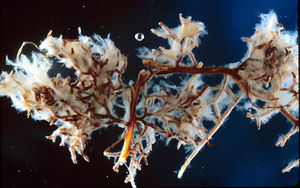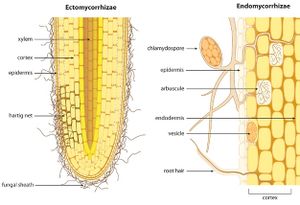Ectomycorrhizal Fungi: Difference between revisions
No edit summary |
No edit summary |
||
| Line 17: | Line 17: | ||
==Symbiotic relationship with plant roots== | ==Symbiotic relationship with plant roots== | ||
In order to attract and form an EcM relationship, plants release metabolites, or small molecules, that encourage hyphae to grow in the direction of the plant root. [7] [[Flavonoids]] are one example of a metabolite exuded by plant roots. [8] Once the hyphae approach and penetrate the outer membrane of the root cap, the fungus can begin to infect the plant. | |||
===Relationship in action=== | |||
| Line 40: | Line 43: | ||
[7] Egerton-Warburton, L. M.; et al. (2003). "Mycorrhizal fungi". Encyclopedia of Soils in the Environment. | [7] Egerton-Warburton, L. M.; et al. (2003). "Mycorrhizal fungi". Encyclopedia of Soils in the Environment. | ||
[8] Martin, Francis; et al. (2001). "Developmental cross talking in the ectomycorrhizal symbiosis: signals and communication genes". New Phytologist. 151 (1): 145–154. doi:10.1046/j.1469-8137.2001.00169.x. | |||
Revision as of 10:59, 9 May 2018

Ectomycorrhizal (ECM) fungi form symbiotic relationships with Plant roots. Only about 2% of the plant species on earth form endomycorrhizal relationships, but therein exist some of the most environmentally and economically important species. [1] EcM fungi tend towards specificity when choosing hosts, while Arbuscular Mycorrhizal Fungi is much more generalized in its choosing.
Structures

Mantle
A layer encasing the outside of the root tip in either a loose gathering or tight alignment of hyphae. The presence of the mantle can sometimes hinder root hair growth if the root is secured tightly.
Hartig net
A network of hyphae strands that work around epidermal and cortical root cells, as they make their way through the cortex towards the middle of the root. [4]
Extraradical hyphae
A fine network of hyphae that extend outward from the encased root, filling the role of the suppressed root hairs. By spreading out into the surrounding soil, the hyphae can extract water and nutrients for transport back to the root.
Fruiting bodies
The most recognizable part of an EcM relationship is the fruiting body. These growths are usually easy to spot with the naked eye. The function of the fruiting body is sexual reproduction to spread the fungus to new hosts.
Symbiotic relationship with plant roots
In order to attract and form an EcM relationship, plants release metabolites, or small molecules, that encourage hyphae to grow in the direction of the plant root. [7] Flavonoids are one example of a metabolite exuded by plant roots. [8] Once the hyphae approach and penetrate the outer membrane of the root cap, the fungus can begin to infect the plant.
Relationship in action
Role in spread of invasive species
Ectomycorrhizal fungi are more specialized in their formation of symbiotic relationships, so they are not hugely involved in the spread of non native species. That said, eucalypt and pine trees are obligate EcM trees and are often grown en masse on plantations, sometimes for commercial use. [5] In New Zealand, Pinus contorta has gained a foothold in natural ecosystems with the help of EcM relationships [6] Pinus contorta is native to the western United States and now compete with co-ocurring with native Nothofagus solandri var. cliffortioides.
References
[1] Tedersoo, Leho; May, Tom W.; Smith, Matthew E. (2010). "Ectomycorrhizal lifestyle in fungi: global diversity, distribution, and evolution of phylogenetic lineages" (PDF). Mycorrhiza. 20 (4): 217–263. doi:10.1007/s00572-009-0274-x. PMID 20191371.
[2] Dighton, J. "Mycorrhizae." Encyclopedia of Microbiology (2009): 153-162.
[3] Smith, Sally E.; Read, David J. (26 July 2010). Mycorrhizal Symbiosis. Academic Press. ISBN 978-0-08-055934-6.
[4] Carlile, M.J. & Watkinson, S.C. (1994) The Fungi. Academic Press Ltd, London. pp 329 - 340.
[5] Díez, Jesús. "Invasion biology of Australian ectomycorrhizal fungi introduced with eucalypt plantations into the Iberian Peninsula" (PDF). Issues in Bioinvasion Science. 2005: 3–15. doi:10.1007/1-4020-3870-4_2.
[6] Dickie, Ian A.; et al. (2010). "Co‐invasion by Pinus and its mycorrhizal fungi". New Phytologist. 187 (2): 475–484. doi:10.1111/j.1469-8137.2010.03277.x. PMID 20456067.
[7] Egerton-Warburton, L. M.; et al. (2003). "Mycorrhizal fungi". Encyclopedia of Soils in the Environment.
[8] Martin, Francis; et al. (2001). "Developmental cross talking in the ectomycorrhizal symbiosis: signals and communication genes". New Phytologist. 151 (1): 145–154. doi:10.1046/j.1469-8137.2001.00169.x.